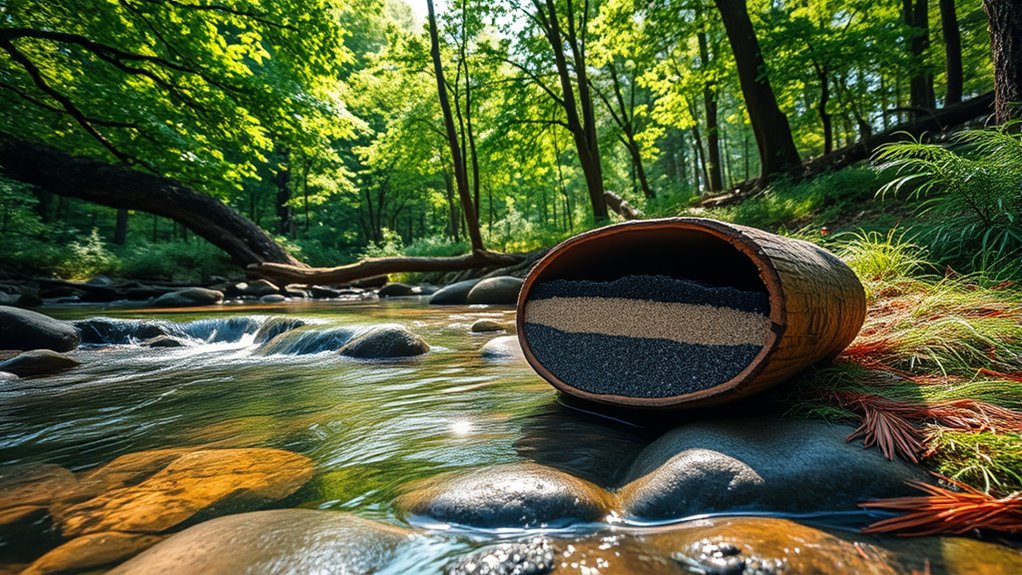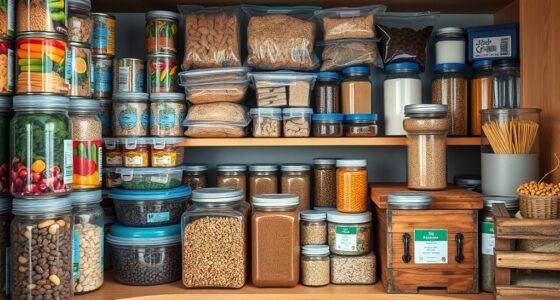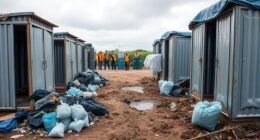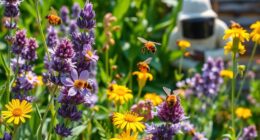To purify water in the wild, start by boiling it for at least one minute to eliminate harmful microorganisms. If you prefer a quick solution, use water purification tablets or drops, following the instructions carefully. Filtration systems can also remove contaminants, but check their capabilities. You can even collect rainwater in clean containers. For more innovative techniques and the best options for emergencies, there's plenty more to discover on effective purification methods.
Key Takeaways
- Boil water for at least one minute to eliminate harmful microorganisms and ensure safety, especially at higher altitudes.
- Use portable filtration devices to remove pathogens and particulates, but check if they filter out chemical contaminants.
- Treat water with purification tablets or drops, following dosage instructions for effective disinfection against bacteria and viruses.
- Set up distillation by boiling water and collecting the steam to effectively remove a wide range of contaminants.
- Utilize solar disinfection by placing clear bottles of water in direct sunlight for six hours to kill pathogens using UV rays.
Understanding Water Sources in the Wild
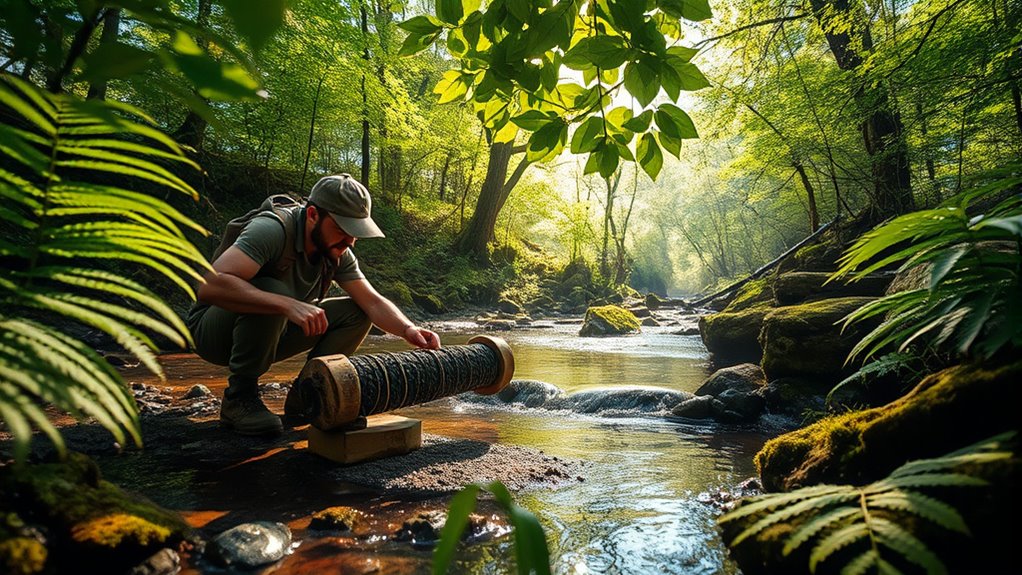
When you're out in the wild, finding reliable water sources is crucial for survival. Start by looking for rivers and streams, which often provide a steady water supply, though their purity can vary.
Large lakes typically offer clearer water, thanks to higher pH levels. Rainwater, especially in non-industrial areas, is generally pure and safe to drink.
Large lakes provide clearer water due to higher pH levels, while rainwater in unpolluted areas is usually safe to drink.
In arid environments, keep an eye out for underground water, found in places like sand dunes. Snow and ice can also supply water in colder climates, but you'll need to melt them first.
Observing green vegetation can guide you to water, as can animal tracks and flight paths. Remember, nature often reveals its water sources if you know where to look.
The Importance of Water Purification

Finding water in the wild is just the first step; ensuring it's safe to drink is where water purification comes into play. Clean water is essential for your survival, supporting your health by aiding in temperature regulation and nutrient transport.
Contaminated water can expose you to dangerous waterborne illnesses like cholera and dysentery, which can be especially harmful to vulnerable populations like children and the elderly.
Moreover, purifying water protects aquatic ecosystems by removing harmful toxins, benefiting both wildlife and agriculture. By ensuring you have access to clean water, you not only safeguard your health but also contribute to environmental conservation and economic development.
Water purification is a vital skill that can mean the difference between life and death in the wild.
Boiling Water: The Most Reliable Method
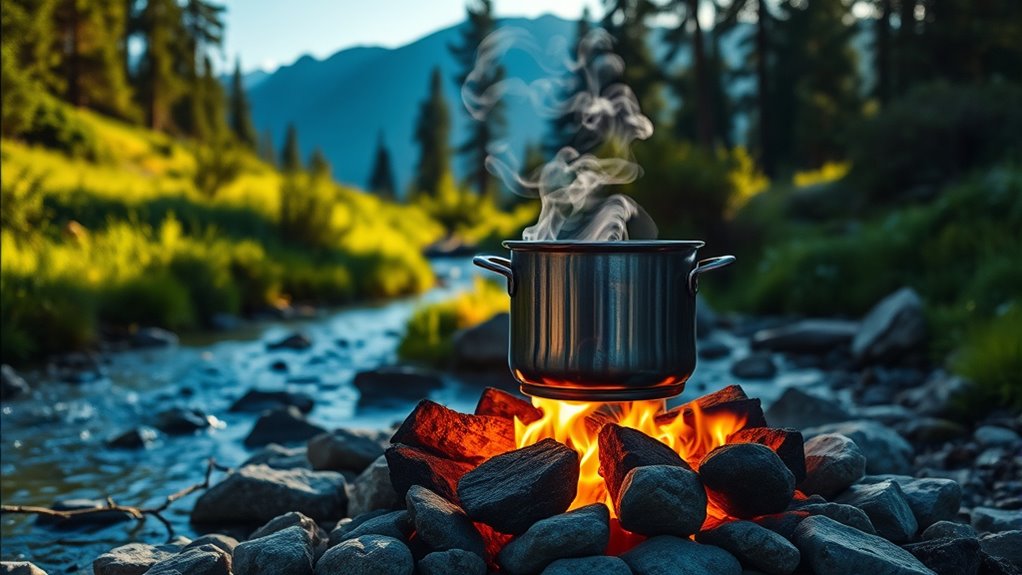
Boiling water stands out as one of the most reliable methods for purification, as it effectively eliminates harmful bacteria, viruses, and parasites. The process is simple: all you need is a heat source and a container.
With no chemicals involved, you avoid the risk of chemical contamination, making boiling a trusted option worldwide. To purify, gather your supplies, and consider filtering or letting the water settle first for better quality.
Boil the water for at least one minute (three minutes at high altitudes) and let it cool before drinking. Store the purified water in a clean, covered container to prevent recontamination.
Utilizing Filtration Systems for Clean Water
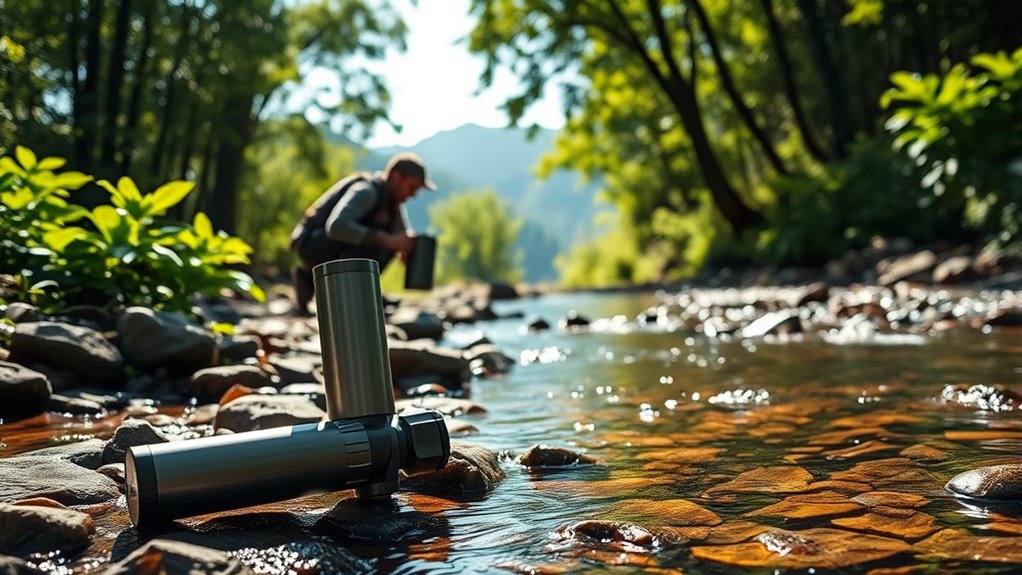
While boiling is a time-tested method for purifying water, utilizing filtration systems offers a versatile and effective alternative for ensuring clean drinking water in the wild.
Boiling water is reliable, but filtration systems provide a flexible and efficient way to ensure safe drinking water outdoors.
You can create natural filters using layers of sand, gravel, or even large rocks to trap sediment. Certain plants, like cattails, absorb impurities, while activated charcoal from burnt wood helps eliminate chemicals and odors.
For portable options, consider ceramic filters, which tackle bacteria and viruses, or DIY solutions using sawdust and sand. Commercial filters, like LifeStraw, provide easy-to-use, reliable purification.
Remember to regularly clean and maintain your filtration systems to keep them effective. Understanding your water source will help you choose the right filtration method for your survival needs.
Chemical Treatments: Iodine and Chlorine
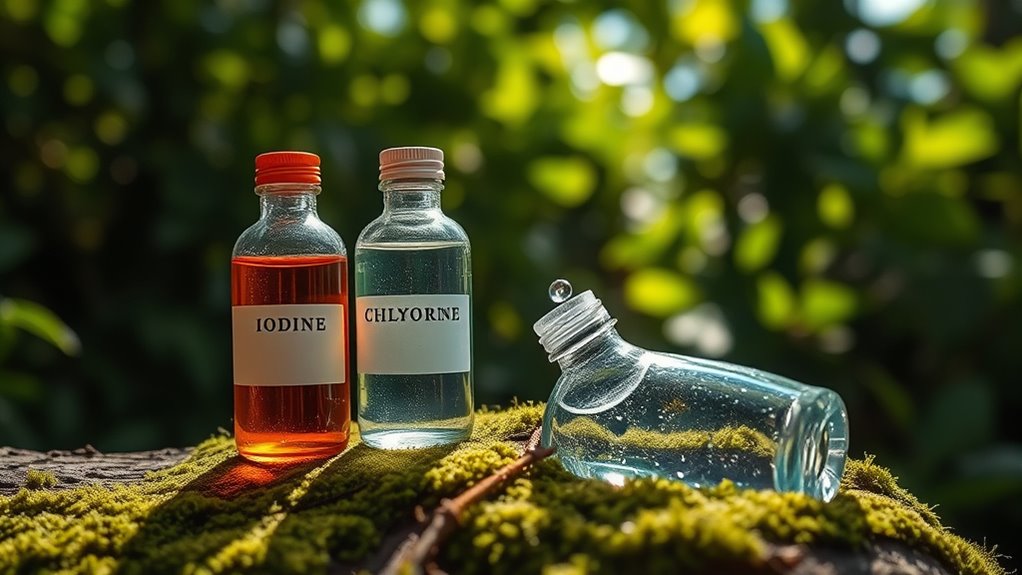
When you're in the wild and need to purify water quickly, chemical treatments like iodine and chlorine can be lifesavers.
Iodine, available in solutions, tablets, and crystals, effectively kills most bacteria and viruses, though it's less effective against protozoa like Cryptosporidium. Typically, you'd use 8 drops of a 2% iodine solution per liter, letting it sit for 15-30 minutes.
Chlorine bleach is another option; it's easy to find and requires careful dosing to avoid toxicity. Similar to iodine, it takes 20-30 minutes to work effectively.
Distillation: Removing Contaminants
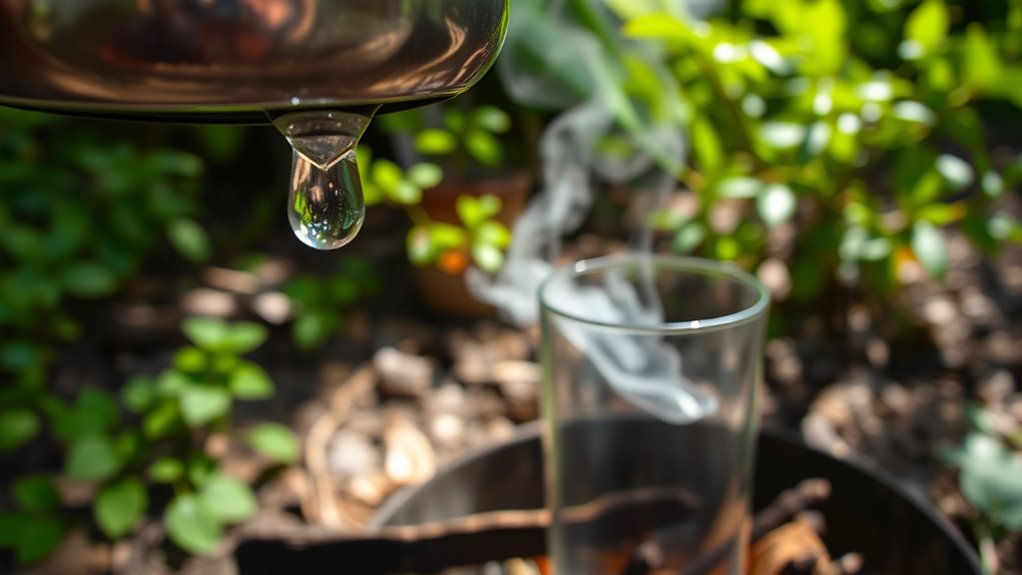
Distillation effectively removes a wide range of contaminants from water, making it an essential purification technique in the wild. This process involves boiling water to create steam, which is then cooled and condensed back into liquid form, leaving behind impurities like salt, heavy metals, and biological agents.
You can improvise a distillation setup using a heat source, a container for boiling, and a simple condenser made from copper tubing or other available materials. Techniques like solar distillation harness the sun's heat, while boiling point distillation separates water based on different boiling points.
Remember to discard the first steam to avoid collecting volatile contaminants and ensure your collection container is clean to prevent re-contamination.
Alternative Purification Methods

In the wild, having a variety of alternative purification methods at your disposal can be crucial for ensuring safe drinking water.
Boiling is one of the simplest methods; just bring the water to a rolling boil for at least five minutes to kill harmful microorganisms.
You can also use chemical treatments like iodine or chlorine tablets, which require a waiting period to be effective.
Portable filters, such as LifeStraw or ceramic filters, are great for removing bacteria and protozoa but won't eliminate viruses.
If sunlight's available, consider using solar disinfection (SODIS) by placing clear containers in direct sunlight.
Collecting Rainwater for Fresh Water

Collecting rainwater is a practical and sustainable way to secure fresh water in the wild.
It's cost-effective, tapping into free resources while enhancing ecological health by reducing soil nutrient loss. You can use roof drainage systems and gutters to direct rainwater into food-grade barrels, ensuring they've sealed lids to prevent contamination.
Consider simple dry systems for low maintenance or wet systems for flexibility in tank placement. Regularly inspect your gutters for blockages and keep your storage containers clean to ensure water quality.
This method not only provides drinking water after treatment but also serves for irrigation and household uses, making it a valuable resource in any survival situation.
Using Natural Filters for Water Purification
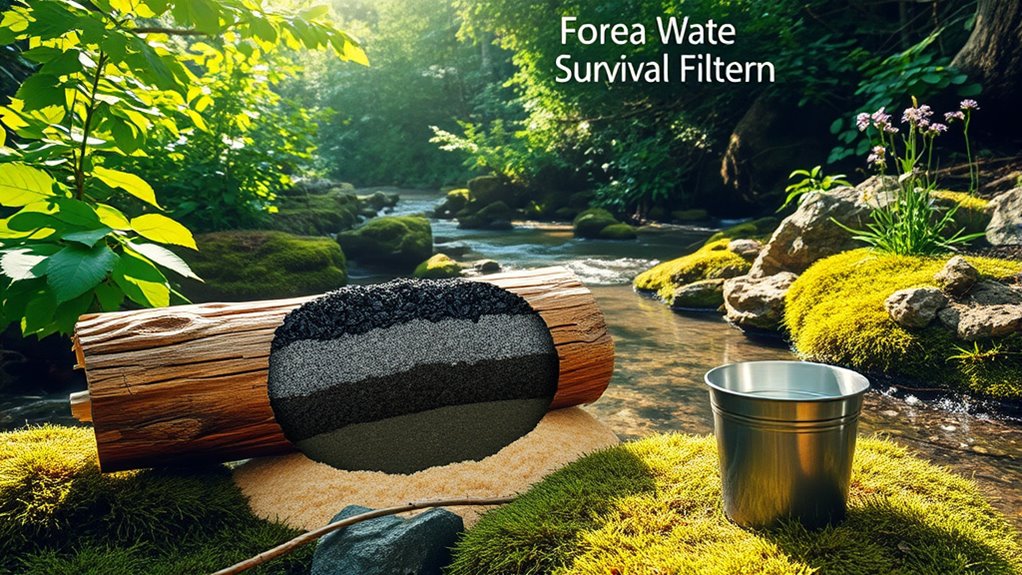
When you're in the wild and need to purify water, using natural filters can be a practical solution that harnesses readily available materials.
Activated charcoal is excellent for removing impurities and chemicals. Moringa oleifera seeds are known for their antimicrobial properties and can trap suspended particles. Crushed corn cobs filter out chlorine and excess salts effectively.
Pine sapwood acts as a natural sieve, filtering bacteria, while coconut husks serve well for greywater filtration. You can ground moringa seeds into a powder and let them sit in water for hours.
Combining these materials creates layered filters using sand and pebbles, enhancing purification. Utilizing these natural resources ensures effective water filtration while being cost-effective and sustainable.
Emergency Water Purification Techniques
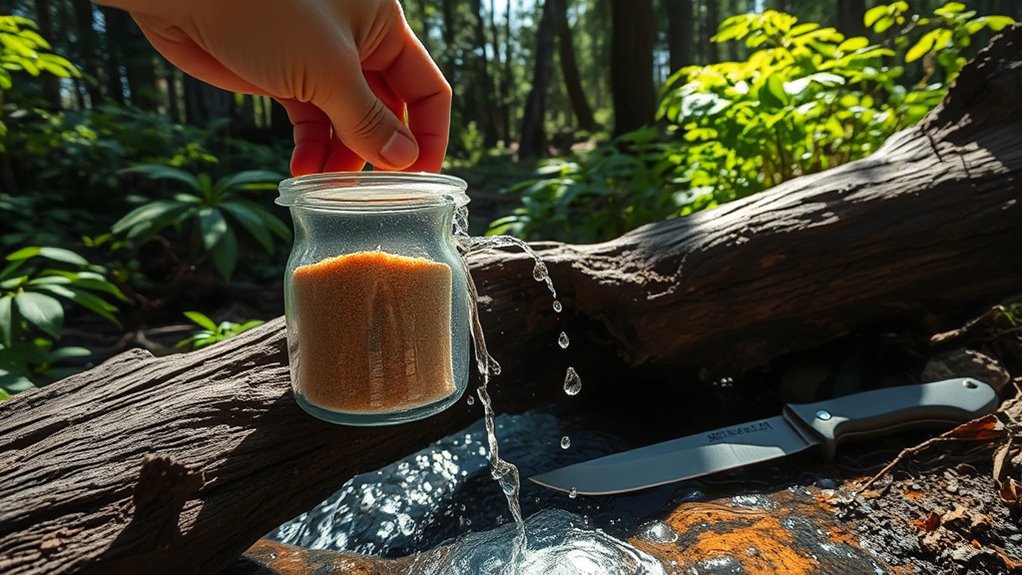
While you might find yourself in a survival situation with limited resources, knowing emergency water purification techniques can be a lifesaver.
Boiling water is your best bet; just bring it to a rolling boil for 1-3 minutes to eliminate harmful pathogens.
If you have chemical tablets or drops, they're effective against bacteria and viruses but won't filter out heavy metals.
Distillation can also work by boiling water and collecting the steam, though it requires some setup.
For a low-tech option, try solar disinfection by placing water in a clear bottle under sunlight for six hours.
Lastly, portable purification devices like survival straws or pumps can help you filter out pathogens on the go, though they may not remove all contaminants.
Frequently Asked Questions
Can I Drink Water Directly From Streams Without Purification?
You shouldn't drink water directly from streams without purification.
Even if the water looks clear, it can contain harmful bacteria, viruses, and parasites that could make you seriously ill.
Contamination can come from various sources like animal waste or human activities.
To stay safe, always purify stream water before drinking, whether by boiling, using filters, or chemical treatments.
Protecting your health is vital, especially in the wild, where access to medical help is limited.
How Can I Identify Safe Plants for Water Collection?
To identify safe plants for water collection, look for large, green leaves that thrive in sunlight.
Avoid plants with thorns or any known toxic qualities. Berry bushes and cacti are usually safe choices.
Always check the surrounding area for healthy plants, as they indicate a safer environment.
Steer clear of stagnant water sources and ensure you wash your hands before handling the leaves to prevent contamination.
Your safety's key!
What Common Mistakes Should I Avoid When Boiling Water?
Did you know that boiling water for just one minute at sea level can eliminate most pathogens?
When boiling water, avoid common mistakes like not boiling long enough or using an inadequate heat source. Overcrowding your container can lead to spills, and don't forget to monitor the temperature.
Always choose clean containers for storage, and ensure they're sealed to prevent re-contamination.
How Do Weather Conditions Affect Water Purification Methods?
Weather conditions significantly influence water purification methods.
When it rains heavily, increased turbidity complicates filtration, making it less effective. You might find that UV light purification struggles in cloudy weather, and chemical treatments require adjustments during storms.
Additionally, portable filters can clog with debris. To adapt, monitor weather forecasts, diversify your water sources, and consider advanced filtration technologies to ensure you maintain clean water access despite fluctuating conditions.
Can I Purify Seawater for Drinking?
Yes, you can purify seawater for drinking, but it requires specific methods.
You can't just boil it, as that won't remove the salt. Instead, consider distillation or reverse osmosis, which effectively remove salts and impurities.
Keep in mind, these methods can be energy-intensive.
If you're in a survival situation, focus on boiling for pathogen elimination and look for alternative freshwater sources to avoid the complexities of seawater purification.
Conclusion
In the wild, you've got to dance with the elements, and understanding water purification is key to your survival. Whether you're boiling, filtering, or mixing in a little chemical magic, it's all about ensuring your sip is safe. Remember, collecting rainwater or using natural filters can also be your allies. So, embrace these methods with confidence, and let nature's gifts nourish you, keeping you refreshed on your adventure. Stay hydrated, stay safe!

